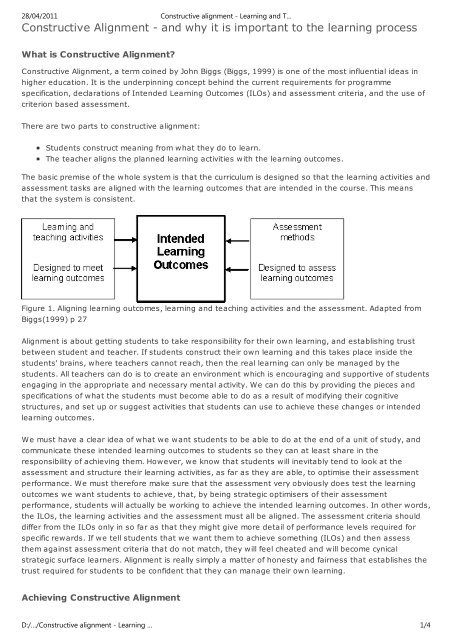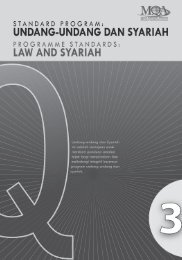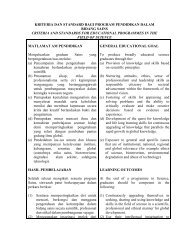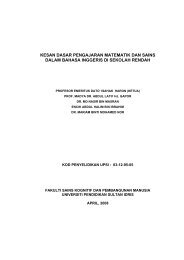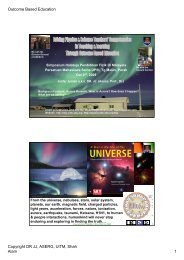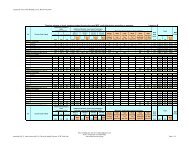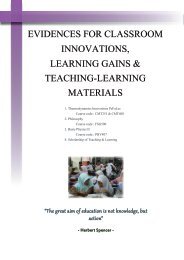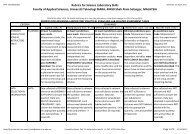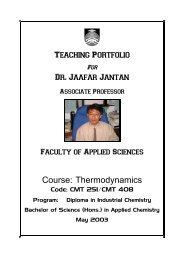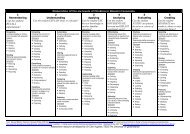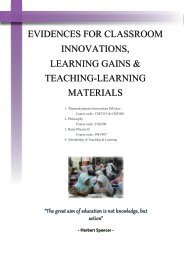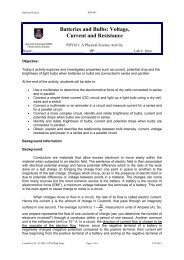Constructive alignment - Learning and Teaching Theory ... - DrJJ
Constructive alignment - Learning and Teaching Theory ... - DrJJ
Constructive alignment - Learning and Teaching Theory ... - DrJJ
Create successful ePaper yourself
Turn your PDF publications into a flip-book with our unique Google optimized e-Paper software.
28/04/2011 <strong>Constructive</strong> <strong>alignment</strong> - <strong>Learning</strong> <strong>and</strong> T…<strong>Constructive</strong> <strong>alignment</strong> is actually extremely difficult to achieve: it is virtually impossible to get it right firsttime, through so-called rational top-down course design. That is why the ILTHE, for example, emphasisesthe importance of the reflective practitioner; the teacher who constantly modifies course design <strong>and</strong>delivery, constantly trying to work closer to the unattainable perfect constructive <strong>alignment</strong>. Moreover, thisis not simply a matter of modifying learning activities <strong>and</strong> assessment. Sometimes, in the delivery of amodule, assessment outcomes, or our work with students, reveal learning outcomes we had notanticipated but that we nevertheless recognise as valuable. These emergent learning outcomes need tobe identified <strong>and</strong> incorporated into the intended learning outcomes. <strong>Constructive</strong> <strong>alignment</strong> cannot beachieved or maintained in an institutional system that does not allow frequent modification of moduledescriptions (figure 2).Figure 2. Concept map illustrating the main ideas put forward by Biggs <strong>and</strong> the relationships betweenthem in the Curriculum Design Process.If we are taking a single component of a programme, we can '<strong>Constructive</strong>ly Align' that course by tacklingthe following steps:Define the learning outcomes.Select learning <strong>and</strong> teaching activities likely to enable the students to attain the outcomes.Assess the students' outcomes <strong>and</strong> grade the students learning.Setting the <strong>Learning</strong> OutcomesThis is how we are intending to define the course for our students, (though the students maybeinfluenced by the assessment). We need to think about the learning as what we want the student to do.We want the students to 'behave' like engineers making competent decisions in their future careers; theoutcomes should mirror this. As we want the students to do things, then it makes sense for the outcomesto be specified in terms of verbs, this will also have the added benefit of leading us to designassessments that measure the objectives.In considering the verbs to describe learning outcomes, we can return to the work on levels <strong>and</strong> thedifferent levels of learning. We will probably want to mix the levels of learning required having some lowerD:/…/<strong>Constructive</strong> <strong>alignment</strong> - <strong>Learning</strong> … 2/4
28/04/2011 <strong>Constructive</strong> <strong>alignment</strong> - <strong>Learning</strong> <strong>and</strong> T…level outcomes that deal with the basic facts, as well as having higher levels that require the students todeal with new situations. This will provide us with the basis of the learning outcomes for our unit.For example if we are aligning a course on networks, then our low level outcomes would be to stateKirchhoff's Law <strong>and</strong> Thevenin's Law. However, we also would want extended underst<strong>and</strong>ing where wewould expect students to apply these laws to new contexts, perhaps designing their own circuits.Selecting <strong>Learning</strong> <strong>and</strong> <strong>Teaching</strong> ActivitiesWe need to consider activities that will cause the students to engage with the learning. Coursedocumentation usually defines the amount of study, in many institutions this is defined in terms of contacttime in lectures <strong>and</strong> tutorials. However, we have seen (see learning styles) that these are not the mosteffective way for the majority of students to learn as they can adopt passive learning approaches.Consequently, we need to consider approaches that require participation that is more active <strong>and</strong>encourage more high-level learning. Therefore, if we want students to consider that we expect them tosynthesize concepts <strong>and</strong> link them together then we should consider assessment activities thatencourage that behaviour, such as a mini-lab project, or a case study such as designing <strong>and</strong> costing anew power plant in a location with particular requirements.Assessing <strong>and</strong> Grading the StudentWe need to ensure that we assess the learning outcomes. If we are seeing how the students applyknowledge of the environment <strong>and</strong> environmental legislation to new situations then that is what weshould assess. However, we should also consider how we assess the student <strong>and</strong> arrive at the finalgrade. We can take two approaches to assessment. The first, the traditional norm assessment model, iswhere we break down the students 'learning' into their responses to individual questions <strong>and</strong> sub units,assigning marks to their 'correct' responses. The problem with this is that it encourages students to playthe assessment game, <strong>and</strong> go for a mark 'trawl' in exams, trying to pick-up bits of marks here <strong>and</strong> there.The alternative is criteria-based assessment where grades are awarded according to how well studentsmeet the desired learning outcomes (see table 1 for an example).ObjectivesGrading will be based on you attaining thefollowing criteria:Demonstrate appreciation <strong>and</strong> underst<strong>and</strong>ingof the delicate balance in the environment.Demonstrate underst<strong>and</strong>ing of sustainability<strong>and</strong> related issues in the environment.Have knowledge of relevant UK <strong>and</strong> EUenvironmental legislations.Relate specific pollution control technologies toindustries.Grading CriteriaGrades will depend on how well you c<strong>and</strong>emonstrate that you have met all objectives:A: Awarded if you have clearly met all theobjectives, displaying deep knowledge of thecontent, creative thinking, applying the conceptseffectively to new situationsB: Awarded when all objectives have been metwell <strong>and</strong> effectivelyC: Awarded when the objectives have beenaddressed satisfactorily, or where evidence isstrong for some objectives, but weaker in others.F: Less than C, or work not submittedAppreciate the range of engineering relatedenvironmental problems.Table 1. A constructively aligned assessment scheme (adapted from Biggs 2003)D:/…/<strong>Constructive</strong> <strong>alignment</strong> - <strong>Learning</strong> … 3/4
28/04/2011 <strong>Constructive</strong> <strong>alignment</strong> - <strong>Learning</strong> <strong>and</strong> T…Nearly all degree programmes will require the criteria grades to be converted to a grade, this is fairlystraightforward; a good ‘A’ gets 78%, a bare ‘A’ gets 70%, <strong>and</strong> so on. For a more in-depth discussion ofassessment, see Biggs(1999) Chapters 8 <strong>and</strong> 9.Advantages of <strong>Constructive</strong> Alignment<strong>Constructive</strong> <strong>alignment</strong> encourages clarity in the design of the curriculum, <strong>and</strong> transparency in the linksbetween learning <strong>and</strong> assessment. In a truly <strong>Constructive</strong>ly Aligned curriculum it facilitates deep learningas the activities are designed for that purpose. This should improve the quality of learning <strong>and</strong> graduatesin our profession.Further ReadingJohn Biggs (1999): <strong>Teaching</strong> for Quality <strong>Learning</strong> at University, (SRHE <strong>and</strong> Open University Press,Buckingham)Norman Jackson (2002) QAA: Champion for <strong>Constructive</strong> Alignment! (Imaginative Curriculum Symposium,November 2002)John Biggs (2003): Aligning <strong>Teaching</strong> <strong>and</strong> Assessment to Curriculum Objectives, (Imaginative CurriculumProject, LTSN Generic Centre)Claus Brabr<strong>and</strong> (2006): "<strong>Teaching</strong> <strong>Teaching</strong> & Underst<strong>and</strong>ing Underst<strong>and</strong>ing"(19-minute award-winning short-film on <strong>Constructive</strong> Alignment).URL: [ http://www.daimi.au.dk/~brabr<strong>and</strong>/short-film/ ]SourceThe chapter above was taken from Houghton, Warren (2004) Engineering Subject Centre Guide: <strong>Learning</strong><strong>and</strong> <strong>Teaching</strong> <strong>Theory</strong> for Engineering Academics. Loughborough: HEA Engineering Subject Centre.Engineering Subject Centre Copyright 2000 - 2010. All rights reserved.D:/…/<strong>Constructive</strong> <strong>alignment</strong> - <strong>Learning</strong> … 4/4


